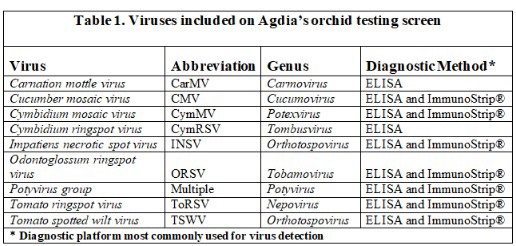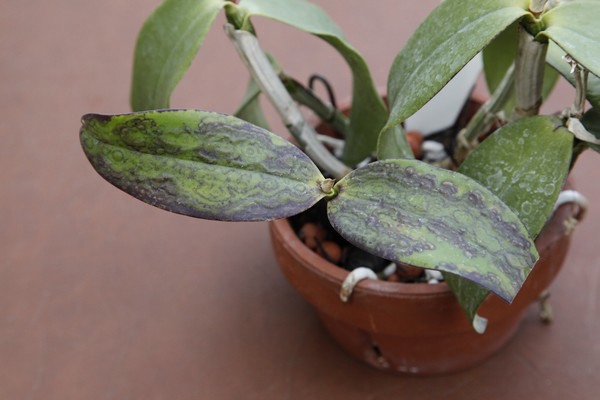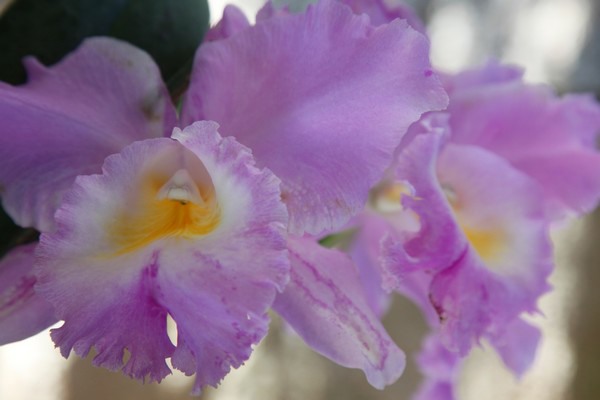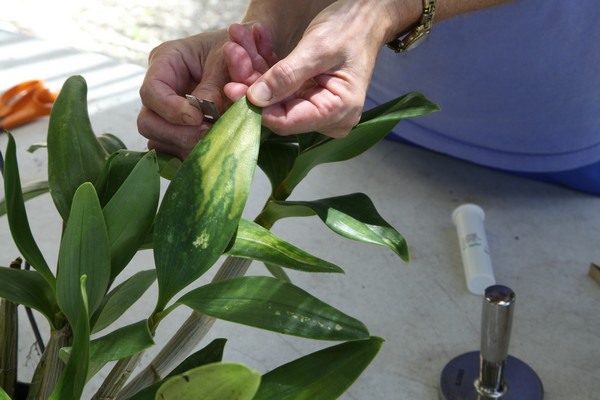Orchids are treasured by their dedicated patrons for beauty, novelty and longevity. Many collections culminate in decades of financial, temporal and emotional investments. Moreover, big-box retail outlets and garden centers have introduced novices to these unique plants by making orchid culture available to the general public at a reasonable price. Availability and affordability have made the orchid sector one of the most economically important for the indoor plant market. Orchids are relatively free of diseases; however, 30 different viruses are recorded infecting this family of prized plants. Many of these viruses cause symptoms soon after infection occurs, impacting aesthetic value, whereas others remain concealed for years within asymptomatic specimens.
by Robert S. Emmitt
Once infected with a virus, an orchid remains infected for life as no curative therapies exist. Therefore, the most effective step in virus management is exclusion of viruses altogether. Diagnostic testing is paramount to identification of infected plants preceding introduction into cherished collections. Viral screens for orchids offered at testing laboratories typically include nine viruses (Table 1.). Moreover, many commercial products are available for purchase, allowing collectors to perform on-site testing. No matter the preferred testing option, growers should consider all suspects to make informed disease management decisions.

Cymbidium mosaic virus (CymMV, Potexvirus) and Odontoglossum ringspot virus (ORSV, Tobamovirus) are the most widely distributed viruses infecting cultivated orchids. Both viruses occur worldwide and cause severe disease in several orchid genera. Moreover, due to similar epidemiological properties, CymMV and ORSV are often transmitted together, causing binary infections. Consequently, collections are most frequently tested for the presence of these viruses, often simultaneously with a single product. Both viruses are stable excluded from hosts and transmitted efficiently via plant-to-plant contact of infected plant sap, during activities such as pruning, re-potting or dividing plants. Long-distance dispersal is through shipment of infected vegetative materials and seed as no arthropod vectors have been identified for either virus. Both viruses infect orchid solely.

Figure 1. Symptoms of ORSV on foliage of Cattleya species (Image courtesy of Terry Bottom, St. Augustine Orchid Society)
Symptoms of CymMV include chlorotic or necrotic streaks on foliage, frequently in mosaic patterns. Moreover, sunken necrotic lesions can occur on leaves, resembling symptoms observed in correlation with fungal infections. Color break and necrotic spots can occur on flowers, but newly opened flowers rarely exhibit symptoms. Symptoms caused by ORSV infections include chlorotic or necrotic ringspots and streaks on foliage and color break on flowers (figures 1. and 2.). Moreover, foliage with typical mild red or violet coloration can manifest extreme red pigmentation. Mixed infections can exacerbate symptoms of both viruses (Figure 3.), whereas less obvious symptoms include stunting, decreased flowering and overall loss of vigor. Symptoms are not definitive diagnostic tools; however, their presence is indicative of physiological dysfunction, prompting analysis. Unfortunately, CymMV and ORSV can cause latent infections, and infected plants can function as asymptomatic reservoirs of inoculum.

Figure 2. Color break symptoms on orchid flowers caused by ORSV infection (Image courtesy of Terry Bottom, St. Augustine Orchid Society)
Orthotospoviruses known to infect orchids include Impatiens necrotic spot virus (INSV), Tomato spotted wilt virus (TSWV) and Capsicum chlorosis virus (CaCV). Symptoms caused by the type virus of this genus, TSWV, were first observed on tomato in 1915. Since then, several additional members have been characterized. All three viruses are transmitted, or vectored, by multiple species of thrips (Order Thysanoptera) in a persistent, propagative manner. Thrips feed on a wide range of plant species, including many common herbaceous perennials and annual horticultural crops planted by homeowners.

Figure 3. Symptoms of a mixed infection of CymMV and ORSV on Dendrobium species (Image courtesy of Terry Bottom, St. Augustine Orchid Society)
The Orthotospoviruses are known to infect over 1000 species of plants throughout the world, making for a long list of potential carriers. Many weedy species such as common chickweed, Stellaria media, can be infected and remain symptomless, acting as reservoirs of virus when cultivated hosts are not available. Mechanical spread of these viruses is less efficient than with CymMV and ORSV, but happens, nevertheless. Symptoms of INSV and TSWV on orchids include stunting and chlorotic ringspots arranged in discrete concentric circles forming a target spot or bull’s-eye appearance. This is due to the feeding patterns of thrips, and symptoms manifest at the point of infection. These spots can coalesce and form sunken necrotic lesions.
Multiple Potyviruses have been identified causing disease in orchids. The type member of this genus, Potato virus Y, was first characterized in 1931, and it is not known to infect orchids. Potyviruses known to infect orchids include Bean yellow mosaic virus (BYMV), Clover yellow vein virus (ClYVV), Dendrobium mosaic virus (DeMV), Phalaenopsis chlorotic spot (PhCSV), Turnip mosaic virus (TuMV) and Vanilla mosaic virus (VanMV). Like the Orthotospoviruses, the Potyviruses infect more than a thousand plant species, and with more than 150 characterized members, Potyvirus is one of the largest genera of plant viruses.
The Potyviruses are transmitted by multiple species of aphids (Order Hemiptera) in a nonpersistent manner. This means the virus can be acquired from an infected plant via feeding, within seconds of stylet insertion. Shortly thereafter, the virus can be transmitted by the vector to healthy plants. This is in contrast to persistent transmission, such as that observed with the Orthotospovirus-thrip relationship. Acquisition of virus by thrips can take several hours, and several days before transmission is possible. Potyviruses are also transmitted mechanically and through seed. Symptoms of Potyvirus infection on orchids include chlorotic spots on foliage and color break on flowers. Leaf and flower distortion symptoms have also been observed.
In addition to the viruses mentioned above, several are known to infect orchids. These include those transmitted by nematodes, such as Tomato ringspot virus (ToRSV, Nepovirus) and Tobacco rattle virus (TRV, Tobravirus). Nematodes are not prevalent in epiphytic bark substrate, and terrestrial orchids are at higher risk of vector-transmitted infections. Nevertheless, both viruses are spread efficiently to epiphytic species via mechanical inoculation. Additional viruses confirmed to infect orchids include Cucumber mosaic virus (CMV, Cucumovirus), Carnation mottle virus (CarMV, Carmovirus), Cymbidium ringspot virus (CymRSV, Tombusvirus) and Orchid fleck virus (OFV, Dichorhavirus).
The symptoms of several viruses are similar and can mimic abiotic issues, such as those caused by nutrient imbalance or environmental variability. Therefore, identification of the suspect pathology through diagnostic testing is the cornerstone of an effective virus management program. Testing can be accomplished at university diagnostic laboratories or private testing facilities. Many private laboratories offer virus testing screens as shown in table 1., providing a way to screen collections for multiple viruses simultaneously. Moreover, several commercial products such as Agdia’s ImmunoStrip® allow collectors to test their plants at home.
Regardless of the testing method, accurate diagnosis is the result. That diagnosis is a data point to be used in the decision-making process, prompting action. Orchid collections represent sizable investments in money, time and emotion, and many plants are historically significant. The price of accurate diagnosis is an important part of the investment, promoting healthy collections for years to come.
For more information: Agdia
Agdia
Robert Emmitt
robert.emmitt@agdia.com
info@agdia.com
www.agdia.com
